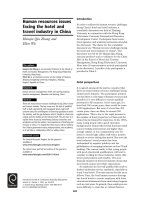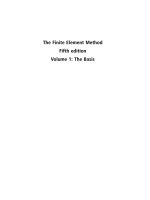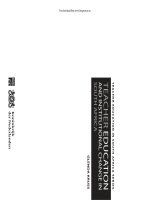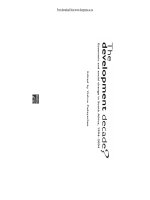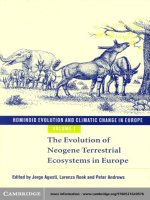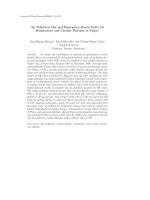HOMINOID EVOLUTION AND CLIMATIC CHANGE IN EUROPE VOLUME 1 The Evolution of Neogene Terrestrial Ecosystems in Europe ppt
Bạn đang xem bản rút gọn của tài liệu. Xem và tải ngay bản đầy đủ của tài liệu tại đây (11.51 MB, 529 trang )
Europe has changed greatly in terms of climate and environment in the past
20 million years. Once, there were sub-tropical forests, but by the end of the
Miocene, 5 million years ago, these had all gone. This unique book provides
evidence for the past climatic history of Europe and the Mediterranean in
relation to hominoid evolution. Many diVerent lines of evidence are brought
together including studies speciWcally on past climates and the application
of climate modelling, the reconstruction of past geographical events, and
the eVects they had on European environments and the plants and animals
living in them. Together, they form a coherent and consistent image of
environmental and climatic change in Europe from 18 to 1.6 million years
ago, for all those interested in mammalian and human evolution.
JORGE AGUSTI is Director of the Institute of Paleontology, M. Crusafont, in Sabadell,
Spain. He specialises in the evolution of the Neogene and Quaternary small mam-
malian faunas in relation to environmental changes.
LORENZO ROOK is a researcher in the Department of Earth Sciences at the University of
Florence, working on fossil primates and carnivora and on Neogene/Quaternary
biochronology.
PETER ANDREWS is a research scientist at the Natural History Museum in London,
where he works on fossil primates, taphonomic and palaeoecological issues relating
to the early stages of human evolution.
XXXXXX
HOMINOID EVOLUTION AND CLIMATIC CHANGE IN EUROPE
VOLUME 1
The Evolution of Neogene Terrestrial
Ecosystems in Europe
XXXXXX
HOMINOID EVOLUTION AND CLIMATIC CHANGE IN EUROPE
VOLUME 1
The Evolution of Neogene
Terrestrial Ecosystems in
Europe
Edited by
JORGE AGUSTI
LORENZO ROOK
and
PETER ANDREWS
Cambridge, New York, Melbourne, Madrid, Cape Town, Singapore, São Paulo
Cambridge University Press
The Edinburgh Building, Cambridge , United Kingdom
First published in print format
ISBN-13 978-0-521-64097-8 hardback
ISBN-13 978-0-511-06619-1 eBook (NetLibrary)
© Cambridge University Press 1999
1999
Information on this title: www.cambrid
g
e.or
g
/9780521640978
This book is in copyright. Subject to statutory exception and to the provision of
relevant collective licensing agreements, no reproduction of any part may take place
without the written permission of Cambridge University Press.
ISBN-10 0-511-06619-8 eBook (NetLibrary)
ISBN-10 0-521-64097-0 hardback
Cambridge University Press has no responsibility for the persistence or accuracy of
s for external or third-party internet websites referred to in this book, and does not
guarantee that any content on such websites is, or will remain, accurate or appropriate.
Published in the United States by Cambridge University Press, New York
www.cambridge.org
Contents
Listofcontributorspagex
Acknowledgements:TheEuropeanScienceFoundationxvii
1IntroductionJorgeAgustı´,LorenzoRookandPeterAndrews1
PART I. Palaeogeography of the circum-Mediterranean region 7
2 Mediterranean and Paratethys palaeogeography during the
Oligocene and Miocene Fred Ro¨gl 8
3 Pliocene tephra correlations between East African hominid
localities, the Gulf of Aden, and the Arabian Sea
Peter B. deMenocal and Francis H. Brown 23
4 Climatic perspectives for Neogene environmental
reconstructions Eileen M. O’Brien and Charles R. Peters 55
PART II. Miocene mammalian successions 83
5 A critical re-evaluation of the Miocene mammal units
in Western Europe: dispersal events and problems of correlation
Jorge Agustı´ 84
6 Large mammals from the Vallesian of Spain
Jorge Morales, Manuel Nieto, Meike Kholer and Salvador
Moya`-Sola` 113
7 Trends in rodent assemblages from the Aragonian
(early–middle Miocene) of the Calatayud-Daroca Basin,
Aragon, Spain Remmert Daams, Albert J. van der Meulen,
Pablo Pelaez-Campomanes and Maria A. Alvarez-Sierra 127
8 The Late Miocene small mammal succession from France,
with emphasis on the Rhoˆne Valley localities Pierre Mein 140
9 Late Miocene mammals from Central Europe
Jens Lorenz Franzen and Gerhard Storch 165
10 An overview on the Italian Miocene land mammal faunas
Lorenzo Rook, Laura Abbazzi and Burkhart Engesser 191
11 The Miocene large mammal succession in Greece
Louis de Bonis and George D. Koufos 205
12 Chronology and mammal faunas of the Miocene Sinap
Formation, Turkey Juha Pekka Lunkka, Mikael Fortelius,
John Kappelman and Sevket Sen 238
13 The Late Miocene small mammal succession in
Ukraine Valentin A. Nesin and Vadim A. Topachevsky 265
PART III. Palaeoenvironments: non-mammalian evidence 273
14 Marine invertebrate (chieXy foraminiferal) evidence
for the palaeogeography of the Oligocene–Miocene of western
Eurasia, and consequences for terrestrial vertebrate migration
Robert Wynn Jones 274
15 Palaeoclimatic implications of the energy hypothesis from
Neogene corals of the Mediterranean region Brian R. Rosen 309
16 Contribution to the knowledge of Neogene climatic
changes in western and central Europe by means of non-marine
molluscs Daniela Esu 328
17 Sedimentary facies analysis in palaeoclimatic reconstructions.
Examples from the Upper Miocene–Pliocene successions of
south-central Tuscany (Italy) Marco Benvenuti, Mauro Papini
and Giovanni Testa 355
18 Neogene vegetation changes in West European and
West circum-Mediterranean areas Jean-Pierre Suc,
Se´verine Fauquette, Mostefa Bessedik, Adele Bertini,
Zhuo Zheng, Georges Clauzon, Danica Suballyova,
Filomena Diniz, Pierre Que´zel, Najat Feddi, Martine Clet,
the late Ezzedine Bessais, Naima Bachiri TaouWq,
Henriette Meon and Nathalie Combourieu-Nebout 378
PART IV. Palaeoenvironments: mammalian evidence 389
19 Shrews (Mammalia, Insectivora, Soricidae) as
paleoclimatic indicators in the European Neogene
Jelle W. F. Reumer 390
20 Mammal turnover and global climate change in the late
Miocene terrestrial record of the Valle`s-Penede`s basin
(NE Spain) Jorge Agustı´, Lluı´s Cabrera, Miguel Garce´s and
Manel Llenas 397
Contents
viii
21 Palaeoenvironments of late Miocene primate localities
in Macedonia, Greece Louis de Bonis, Genevieve Bouvrain and
George D. Koufos 413
22 The paleoecology of the Pikermian Biome and the
savanna myth Nikos Solounias, J. Michael Plavcan,
Jay Quade and Lawrence Witmer 436
23 Vicariance biogeography and paleoecology of Eurasian
Miocene hominoid primates Peter Andrews and
Raymond L. Bernor 454
Index 488
Contents
ix
Contributors
Laura Abbazzi
Dipartimento di Scienze della Terra, Universita´ di Firenze, via G. la Pira 4,
50121 Firenze, Italy
Jorge Agustı´
Institute of Paleontology, M. Crusafont, Escola Industrial 23, E-08201
Sabadell, Spain
Maria A. Alvarez-Sierra
Departamento de Paleontologia y UEI, Facultad de Ciencias Geolo´gicas,
Universidad Complutense y CSIC, Ciudad Universitaria, 24040 Madrid,
Spain
Peter Andrews
Department of Palaeontology, Natural History Museum, Cromwell Road,
London SW7 5BD, UK
Marco Benvenuti
Dipartimento di Scienze della Terre, Universita´ di Firenze, via G. la Pira 4,
50121 Firenze, Italy
Raymond L. Bernor
Department of Anatomy, Laboratory of Paleobiology, Howard University,
520 W. Street, Washington DC 20059, USA
Adele Bertini
Dipartimento di Scienze della Terre, Universita´ di Firenze, via G. la Pira 4,
50121 Firenze, Italy
Mostefa Bessedik
Institute des Sciences de la Terre, Universite´ d’Oran Es-Se´nia, BP 1524, DZ
31100 Oran, Algeria
the late Ezzedine Bessais
Genevieve Bouvrain
Lab. Pale´ontologie des Verte´bre´s et Pale´ontologie humaine, Universite´
Pierre et Marie Curie, 4 place Jussieu, 75005 Paris, France
Francis H. Brown
Department of Geology and Geophysics, University of Utah, Salt Lake City,
UT 84112, USA
Lluı´s Cabrera
Grup de Geodinamica i Analisi de Conques, Department de EstratigraWai
Paleontologia, Universitat de Barcelona, Campus Pedralbes, E-08028
Barcelona, Spain
Georges Clauzon
CEREGM (UMR 6635 CNRS), Europoˆle de l’Arbois, BP 80, 13545
Aix-en-Provence Cedex 04, France
Martine Clet
Morphodynamique continentale et coˆtiere, Universite´ de Caen, 24 rue des
Tilleuls, 14000 Caen, France
Nathalie Combourieu-Nebout
Pale´ontologie et Stratigraphie (ESA 7073 CNRS), case courrier 106,
Universite´ Pierre et Marie Curie, 4 place Jussieu, 75252 Paris Cedex 05,
France
Remmert Daams
Departamento de Paleontologia y UEI, Facultad de Ciencias Geolo´gicas,
Universidad Complutense y CSIC, Ciudad Universitaria, 24040 Madrid,
Spain
Louis de Bonis
Lab. Ge´obiologie, Biochronologie et Pale´ontologie humaine, Faculte´de
Sciences, Universite´ de Poitiers, 40 av du Recteur Pineau, F 86022 Poitiers
Cedex, France
Peter B. deMenocal
Lamont-Doherty Earth Observatory, Columbia University, Palisades, NY
10964, USA
Filomena Diniz
Departamento de Geologia, Universidade de Lisboa, rua Escola
Polytecnica 58, 1294 Lisboa Codex, Portugal
Burkhart Engesser
Naturhistorisches Museum, Agustinergasse 2, CH 4001 Basel, Switzerland
Daniela Esu
Dipartimento di Scienza della Terra, Universita´ ‘La Sapienza’, P. le A.
Moro, 5, 00185 Roma, Italy
Se´verine Fauquette
Lab. de Botanique Historique et Palynologie, Inst. Me´diterrane´en
d’Ecologie et de Pale´oe´col., Faculte´ des Sciences de Saint Je´roˆme, 13397
Marseille Cedex 20, France
Contributors
xi
Najat Feddi
De´partment des Sciences de la Terre, Faculte´ des Sciences Semlalia,
Universite´ cadi Ayyad, avenue Prince Moulay Abdellah, BP S15 Marrakech,
Morocco
Mikael Fortelius
Finnish Mueseum of Natural History, University of Helsinki, PO Box 11,
0014 Helsinki, Finland
Jens Lorenz Franzen
Forschungsinstitut Senckenberg, Senckenberg-Anlage 25, D-60325
Frankfurt am Main, Germany
Miguel Garce´s
Grup de Geodinamica i Analisi de Conques, Department de EstratigraWai
Paleontologia, Universitat de Barcelona, Campus Pedralbes, E-08028
Barcelona, Spain
Robert Wynn Jones
BP, Exploration Operating Co. Ltd, Chertsey Road, Sunbury on Thames
Middlesex TW16 7LN, UK
John Kappelman
Department of Anthropology, University of Texas at Austin, Austin, TX
78712-1086, USA
Meike Kholer
Institute of Pakontology, M. Crusafont, Escola Industrial 23, E-08201
Sabadell, Spain
George D. Koufos
Department of Geology & Physical Geography, School of Geology, Aristotle
University of Thessaloniki, 540 06 Thessaloniki, Macedonia, Greece
Manel Llenas
Institute of Paleontology, M. Crusafont, Escola Industrial 23, E-08201
Sabadell, Spain
Juha Pekka Lunkka
Finnish Museum of Natural History, University of Helsinki, PO Box 11,
0014 Helsinki, Finland
Pierre Mein
Centre des Sciences de la Terre, Universite´ Lyon I, 43, Bd du 11 Novembre
1918, 69622 Villeurbanne-Cedex, France
Contributors
xii
Henriette Meon
UFR des Sciences de la Terre, Universite´ Claude Bernard – Lyon I, 27–43
boulevard du 11 Novembre, 69622 Villeurbanne Cedex, France
Jorge Morales
Museo Nacional de Ciencias Naturales, CSIC, Jose´ Gutierrez Abascal 2,
E-28006, Madrid, Spain
Salvador Moya`-Sola`
Institute of Pakontology, M. Crusafont, Escola Industrial 23, E-08201
Sabadell, Spain
Valentin A. Nesin
Institute of Zoology, Ukrainian Academy of Sciences, 15 Bogdan
Khmelnitsky Str, 252030 Kiev 30, Ukraine
Manuel Nieto
Museo Nacional de Ciencias Naturales, CSIC, Jose´ Gutierrez Abascal 2,
E-28006, Madrid, Spain
Eileen M. O’Brien
School of Forestry, Wales, Bangor, Gwyned, LL57 2UW
Mauro Papini
Dipartimento di Scienze della Terre, Universita´ di Firenze, via G. la Pira 4,
50121 Firenze, Italy
Pablo Pelaez-Campomanes
Museo Nacional de Ciencias Naturales, Jose´ Gutierrez Abascal 2, E-28006,
Madrid, Spain
Charles R. Peters
Institute of Ecology, University of Georgia, Athens, GA 30602, USA
J. Michael Plavcan
New York College of Osteopathic Medicine, Old Westbury, NY 11546, USA
Jay Quade
Department of Geosciences, University of Arizona, Tucson, AZ 85721, USA
Pierre Que´zel
Lab. de Botanique Historique et Palynologie, Inst. Me´diterrane´en
d’Ecologie et de Pale´oe´col., Faculte´ des Sciences de Saint Je´roˆme, 13397
Marseille Cedex 20, France
Contributors
xiii
Jelle W. F. Reumer
Natuurmuseum, Rotterdam, PO Box 23452, NL 3001 KL Rotterdam, The
Netherlands
Fred Ro¨gl
Naturhistorisches Museum. Geol. Palaeont. Abt, Burgring 7, A-1014,
Vienna, Austria
Lorenzo Rook
Dipartimento di Scienze della Terre, Universita´ di Firenze, via G. la Pira 4,
50121 Firenze, Italy
Brian R. Rosen
Department of Palaeontology, The Natural History Museum, Cromwell
Road, London SW7 5BD, UK
Sevket Sen
Lab. de Paleontologie des Verte´bre´s, Universite´ Pierre et Marie Curie, 4
Place Jussieu, 75252 Paris, France
Nikos Solounias
New York College of Osteopathic Medicine, Old Westbury, NY 11546, USA
Gerhard Storch
Forschungsinstitut Senckenberg, Senckenberg-Anlage 25, D-60325
Frankfurt am Main, Germany
Danica Suballyova
UFR des Sciences de la Terre, Universite´ Claude Bernard – Lyon I, 27–43
Bd du 11 Novembre 1918, 69622 Villeurbanne Cedex, France
Jean-Pierre Suc
Centre de Pale´ontologie Stratigraphique et Pale´oe´cologie (UMR 5565),
Universite´ Claude Bernard – Lyon I, 27–43 Bd du 11 Novembre 1918, 69622
Villeurbanne Cedex, France
Naima Bachiri TaouWq
De´partment de Ge´ologie, Faculte´ des Sciences Ben M’Sik, Universite´
Hassan II Mohammedia, BP 7955, Casablanca, Morocco
Giovanni Testa
Dipartimento di Scienze della Terre, Universita´ di Firenze, via G. la Pira 4,
50121 Firenze, Italy
Vadim A. Topachevsky
Institute of Zoololgy, Ukrainian Academy of Sciences, 15 Bogdan
Khmelnitsky Str, 252030 Kiev 30, Ukraine
Contributors
xiv
Albert J. van der Meulen
Department of Stratigraphy & Paleontology, Institute of Earth Sciences,
Budapestlaan 4, 3508 TA, Utrecht, The Netherlands
Lawrence Witmer
Department of Biological Sciences, Ohio University, Athens, OH 45701,
USA
Zhuo Zheng
Faculty of Geology, Zhongshang University, 510275 Guangzhou, People’s
Republic of China
Contributors
xv
Acknowledgements: The European
Science Foundation
The European Science Foundation (ESF) acts as a catalyst for the
development of science by bringing together leading scientists for funding
agencies to debate, plan and implement pan-European scientiWc and
science policy initiatives.
ESF is the European association of more than 60 major national funding
agencies devoted to basic scientiWc research in over 20 countries. It
represents all scientiWc disciplines: physical and engineering sciences, life
and environmental sciences, medical sciences, humanities and social
sciences. TheFoundation assistsits MemberOrganisations intwo main ways
ways: by bringing scientists together in its scientiWc pro-
grammes, networks, exploratory workshops and European
researchconferences,to work on topicsof commonconcern;
and through the joint study of issues of strategic importance
in European science policy.
It maintains close relations with other scientiWc institutions within and
outside Europe. By its activities, the ESF adds value by cooperation and
coordination across national frontiers and endeavours, oVers expert
scientiWc advice on strategic issues, and provides the European forum for
fundamental science.
1 Introduction
Jorge Agustı´, Lorenzo Rook and Peter Andrews
The late Neogene (the period between − 14 and − 2.4 Ma) is one of the most
interesting phases in understand the present conWguration of terrestrial
ecosystems. It was during this time that the change took place from the
middle Miocene dominant subtropical forests that stretched across south-
ern Europe and western Asia to a more open but still wooded biotope that
now prevails in warm–temperate areas. This change in vegetation, which
strongly aVected the composition of mammalian faunas, seems to be linked
to the rapid spread of grasses around 8–10 Ma ago. Moreover, in the late
Neogene, climatic shifts and falling temperatures due to the spread of the
Antarctic Ice, were followed by the Plio-Pleistocene Arctic glaciations in the
Northern Hemisphere. Furthermore, during the late Neogene, important
changes at the regional level gave rise to the present conWguration of the Old
World land masses, and the successive drying of inland seas in the European
area facilitated faunal interchange between Europe and Central Asia and
Africa. At the same time, other tectonic processes like the Himalayan and
the Tibetan uplifts and the opening up of the great eastern African basins
and Red Sea, although working in opposite directions, favoured the pro-
cesses of speciation and isolated evolution.
All these phenomena must have had a strong inXuence on hominid
evolution between 14 and 2 million years ago (Ma). The diversity of hominid
species recorded in that period must be considered in relation to the chang-
ing environmental conditions and to constrictions imposed by the existence
of signiWcant zoogeographical barriers. As a consequence, at around 10 Ma
ago Eurasia displayed a large variety of apes, with gracile forest-dwellers
(Dryopithecus, Sivapithecus), dry-adapted forms (Ankarapithecus) and large
robust gorilla-like forms (Graecopithecus), and all this variety in a period
when there is a huge information gap in Africa. In some ways, the Eurasian
Miocene radiation of apes parallels the trends observed in Africa 5 Ma later
that led to the appearance of the Wrst bipedal hominids. DiVering from the
Pliocene hominid evolution in Africa, the changing environments did not
result in Eurasia in the emergence of bipedal apes, but in the extinction of
generalised morphotypes and the persistence of highly specialised forms in
relic areas (Gigantopithecus, Pongo). However, knowledge of the ecosystems
in which hominids of the late Miocene evolved is still incomplete, and very
little integrated analysis of data has been attempted, in particular making
use of modern techniques for palaeoenvironmental analysis such as iso-
topes, pollen, micromammals.
In order to focus on these issues and to foster co-operation between
scientists dealing with them, the scientiWc network ‘Hominoid evolution
and environmental change on the Neogene of Europe’ was approved by
the European Science Foundation in 1995. One of the goals of this net-
work was to create a database on Neogene Mammals of Eurasia, that
could be used for further analysis of the ecosystems where hominoids
lived. The network also organised three workshops in order to analyse
diVerent aspects of the late Neogene time and their relevance to hominoid
evolution.
The Wrst workshop was held in Sant Feliu de Guixols (Spain), from
the 24th to the 27th of October 1997, and had as the main topic ‘The
Vallesian’. For analysing this particular interval of the late Miocene, 24
scientists from 11 countries attended this Wrst workshop. The workshop
was mainly devoted to analysing the faunal and environmental changes
that took place during the period known as the Vallesian stage. However,
this analysis was not strictly limited to that period but included also the
intervals immediately preceding and succeeding the Vallesian (eg., late
Aragonian and early Turolian). In this way, a number of presentations
dealt with regional mammalian successions ranging from Spain to South-
ern Asia: Spain (Agustı´ et al., Morales et al.), France (Mein), Italy (Rook &
Engesser), Central Europe (Franzen & Storch), the Aegean area (Koufos &
De Bonis), Anatolia (Fortelius et al.) and Eastern Europe (Nesin
& Topachersky). In the case of Eastern Spain, the communications pres-
ented by the Spanish team were complemented with a Weld-trip in the
Valle`s-Penede`s Basin, which enabled the participants to have an accurate
idea of the work developed in this area.
The emphasis of the workshop was put on the comparison and close
correlation of long sections bearing sequences of large and small mammal
localities, instead of the usual correlation between isolated localities lacking
an accurate geological context (for instance, in the case of karstic Wssure
inWllings). In this way, comparison could be made between sections bearing
a detailed magnetostratigraphic analysis, particularly the sections of the
Potwar Plateau (Pakistan), the Valle`s-Penede`s (Spain) and Sinap (Turkey).
Another signiWcant topic of the workshop was the so-called ‘Mid-Vallesian
Crisis’, an extinction event that followed the change from the middle to the
late Miocene. Results reviewed at the workshop suggested that a change
similar to the Mid-Vallesian Crisis of Western Europe occurred at diVerent
times in diVerent areas. The change was already established in the early
Vallesian in the so-called Sub-Parathetyan Province (data from Maragheh
by Bernor), but in Western Europe did not take place until about 9.6 Ma ago
(data from the Valle`s-Penede`s by Agustı´ and co-workers). On the other
hand, in Central Europe, several species indicating wet, forested conditions
persisted well into the late Vallesian (data from Franzen & Storch). Finally,
Introduction
2
such a change was not seen in Southern Asia (Pakistan) until 8–7.2 Ma (data
from the Potwar Plateau).
The second workshop took place in Certosa di Portignano (Siena, Italy),
devoted to the ‘Climatic and environmental change in the Neogene of
Europe’; 25 scientists from 11 countries and diVerent palaeoenviromental
disciplines had the rare opportunity to experience a real interfacing of data
from the terrestrial ecosystems, the shallow marine realm and the deep sea.
A Wrst set of contributions dealt with the palaeogeographic evolution of the
Tethys area and the eVects of changes in the extent of the Tethys sea on
faunal distributions and climate evolution. F. Ro¨gl (Vienna) presented a
sketch of the evolution of this area from the early Tertiary to the late
Miocene. With the contact between the Arabian plate and the Anatolian
plate, land bridges formed between Africa and Eurasia opened and closed
throughout the middle Miocene, beginning about 19 Ma. No hominoid
primates are known this early in Europe, but of particular signiWcance to
hominoid migrations was the end-Burdigalian regression of the sea at
around 16 Ma, as this coincides with the earliest evidence of hominoids in
central Europe.
Contributions to climate modelling during the late Neogene were pro-
vided by P. B. DeMenocal & F. H. Brown, and by E. O’Brien. According to
DeMenocal & Brown, marine records of African climatic variability docu-
ment a shift toward prolonged and seasonally more arid conditions after 2.8
Ma. This is linked to cold North Atlantic sea-surface temperatures asso-
ciated with onset of Arctic Ice sheets. Major changes in African faunas
coincide with this climatic change suggesting that some speciation events
may have been climatically mediated. E. O’Brien demonstrated that a large
proportion (79%) of African woody plant species richness is accounted for
by two aspects of climate, annual rainfall and an optimised function of
energy (minimum monthly potential evapotranspiration). Finally, the
palaeobotanical approach included the point of view of the palynological
analysis (J. P. Suc, A. Bertini, G. Clauzon & D. Suballyova).
Evidence for climate change was considered both from invertebrate and
vertebrate evidence. Data presented by Rosen demonstrated that most coral
reefs (and their associated z-corals) occur in the Mediterranean area in three
major high sea-level phases, corresponding to the early (Aquitanian),
middle (Langhian–Serravalian) and late Miocene (Tortonian–early Mess-
inian). Small mammals were discussed by Reumer (Insectivores), Daams et
al. (rodents from Central Spain) and Agustı´ et al. (mainly rodents from
Eastern Spain). According to Reumer, ecological studies have shown that
environmental moisture may be the ultimate determinant of within-habitat
diversity and numerical abundance of soricids, which can be taken as a good
Introduction
3
indicator of relatively warm and humid palaeoclimate. Shrews (Soricidae,
Insectivora) are among the most relatively sensitive mammals against cli-
matic shifts because of their small size and high surface/volume ratio. Three
main periods of faunal turnover, corresponding to humid and warm condi-
tions, characterise the Neogene history of shrews: the early Miocene (19–20
Ma), the early–late Miocene (Vallesian; 9–11 Ma), and the latest Miocene to
Pliocene (6 and 2.5 Ma). Climatic deterioration at around 2.7–2.3 Ma Wnally
caused a severe reduction of the European shrew fauna. Among rodents, the
analysis of the Calatayud-Daroca succession developed by Daams and co-
workers also suggests, as for the shrews, that species diversity is more
related to relative humidity than to temperature. Quantitative analysis of the
rodent succession developed by Agustı´ and coworkers in the Valle`s-Penede`s
Basin allows the recognition of an alternation of dry and humid phases
during the Miocene and early Pliocene times. Early Miocene localities indi-
cate forested, humid conditions, similar to those recorded in the early
Miocene of Central Europe. Increasingly dry conditions are recorded across
the late early and middle Miocene (early middle Aragonian), but a return to
more humid conditions is observed in the late Aragonian (Serravallian)
times. The middle/late Miocene boundary coincides with a relatively dry
period, followed again by a humid peak in the early Vallesian (early Tor-
tonian), and it is this time that coincides with the maximum abundance of
hominoid remains in Western Europe. Again, as in the case of shrews, it
appears that species diversity is more related to relative humidity than to
temperature.
Contributions dealing with large mammal associations were those of N.
Solounias, M. Plavcan, L. Witmer & J. Quade, L. de Bonis & G. Koufos, L.
Kordos, and R. Bernor. After a detailed analysis based on a variety of sources
(dental and postcranial ecomorphology of bovids, palynology, isotopes),
Solounias and co-workers arrived to the conclusion that the main habitat of
the Pikermian mammals was not a savanna (‘the savanna myth’), but
sclerophyllous evergreen woodland similar to today’s mixed monsoon for-
est and grassland glades of north Central India. Large mammals with lucky
exaptations migrated into Africa from the Pikermian bioprovince. A similar
topic was developed by de Bonis & Koufos, who found in Greek faunas
evidence of a trend towards drier conditions in the late Miocene. On the
other hand, the disappearance of hominoids and other forest elements in
the Pannonian Basin at 9–7 Ma was attributed by Kordos to the regression of
the Pannonian sea rather than to a general climatic trend. Finally, Bernor &
Andrews discussed the patterns of hominoid immigration, dispersal and
extinction. Hominids entered Europe in the middle Miocene because land
crossings of the Tethys were possible at this time and the subtropical forest
Introduction
4
environments were suitable. By virtue of the taxonomic diversity and re-
stricted biogeographic ranges alone, Eurasian Miocene hominids show
strongly vicariant evolutionary patterns. This suggests a model whereby a
founding species extends its range under favourable and speciWc environ-
mental circumstances and then becomes geographically restricted to
refugia by geographic ( = tectonic and palaeogeographic) and/or environ-
mental events. A frequent byproduct of vicariance, exercised over millions
of years time, is homoplasy, and it is evident that there was a great deal of
homoplasy in Miocene hominids.
The nature of the environments occupied by apes in Europe had many
structural similarities with the environments in Africa with which they are
associated at this time. Palaeoecological evidence suggests that African
middle Miocene apes lived in seasonal woodlands and forests, for example
at Fort Ternan and Maboko Island. The hominids at these sites were partly
terrestrial and with their large thick-enamelled teeth were adapted for
similar diets to some of the European apes. The earliest European apes were
similar in being both partly terrestrial and with almost identical dietary
adaptations. The community structure of the mammalian faunas in the
African and European sites were extremely similar, and by inference the
ecosystem they occupied was also similar. The similarities in locomotor and
dietary adaptations of the African and European apes at this early stage
indicate further that their position in their respective ecosystems was also
very similar. In one sense, therefore, these middle Miocene taxa in Europe
were not as distinct from their African relatives as taxonomic divisions and
their geographic separation may appear to indicate.
Towards the end of the middle Miocene, at 13–12 Ma, the trends of
partial terrestriality and thick-enamelled frugivory continued in a group of
fossil apes assigned either to the pongine clade or to a paraphyletic group
unrelated to any living. They are associated with a range of open forest to
woodland environments ranging from southeast Europe to China, and one
genus at least may be related to the orang utan. At the same time, the more
arboreal and suspensory Dryopithecus emerged in association with closed
subtropical forest environments where they are sometimes found asso-
ciated with Pliopithecus and Anapithecus. Similar environments and a simi-
lar, possibly heritage, adaptation for suspensory locomotion persisted in
Oreopithecus, although it has recently been argued that this fossil ape may
also have had adaptations for terrestrial bipedal mode of locomotion and
the evolutionary relationships of Oreopithecus are still unclear.
Later in the Miocene, the Alpine–Himalayan orogeny caused major
changes in land–sea relations, global climatic circulation patterns and sea-
sonality particularly in Central Asia. Regression of the Paratethys likewise
Introduction
5
caused a shift of habitats to greater seasonality and replacement of ever-
green subtropical forests by deciduous woodlands and, progressively in the
late Miocene, more seasonal warm temperate woodlands with progressively
more open habitats. Hominid primate distribution tracked these changes
closely during the 12–9 Ma interval, contracting their range from both west
and east and Wnding temporary refuge in southeastern Europe, where
favourable subtropical conditions persisted for a time after being lost else-
where. Hominids disappeared from this region Wnally during MN11, al-
though they persisted until MN12 in local insular habitats in Italy and the
latest Miocene of China.
Introduction
6
PART I
Palaeogeography of the
circum-Mediterranean region
2 Mediterranean and Paratethys
Palaeogeography during the
Oligocene and Miocene
Fred Ro¨gl
Introduction
The Cenozoic conWguration of continents and oceans is strongly inXuenced
by plate tectonic movements. Opening and closing pathways for mammal
migrations and marine exchanges are one of the triggering forces for faunal
events and evolution. The impacts of a vanishing Tethys Ocean in the
mid-Cenozoic are not only important for the marine and continental biotas
of Eurasia and the Mediterranean, but also inXuenced the environmental
conditions worldwide. The dispersal of continents in the Southern Hemi-
sphere with the northward movement of the Indian and Australian conti-
nents, together with the counterclockwise rotation of Africa, closed down
the Tethys Ocean. Parallel to these movements the Atlantic Ocean opened.
The Mesozoic oceanic circulation patterns changed to varying conditions
with decreasing temperatures in the Cenozoic. Based on oxygen isotopes
(Kennett, 1995), bottom water temperatures were highest in the late
Palaeocene–early Eocene (c. 55 Ma). Distinct steps to colder conditions
followed around the Eocene/Oligocene boundary (33–35 Ma), in the middle
Miocene (15 Ma), and in the Pliocene (3 Ma).
DiVerent palaeogeographic reconstructions over the past two decades
have attempted to solve the development of the Cenozoic Mediterranean
and Paratethys areas. In many cases these reconstructions depend on the
present sediment distribution and do not consider palinspastic reconstruc-
tions based on plate tectonic movements (e.g. Vinogradov, 1967–69; Senes &
Marinescu, 1974; Steininger et al., 1985a; Hamor & Halmai, 1988; Cahuzac et
al., 1992; Popov et al., 1993). Other reconstructions include too long a time
span within one time slice to present a distinct time level within a strongly
changing environment (e.g. Biju-Duval et al., 1977; Dercourt et al., 1985,
1993). The best reconstructions, based on tectonic, sedimentological and
stratigraphic investigations are currently available for the Western Mediter-
ranean (Boccaletti et al., 1986, 1990). The sketches for the Neogene, pro-
duced by Ro¨gl & Steininger (1983) and Steininger & Ro¨gl (1984), were based
on plate tectonic hypotheses, sediment distribution, Eurasian mammal
migrations, and marine faunal similarities between the Mediterranean and
Paratethys. At that time the information on faunal development and strati-
graphic correlation was poor for the Eastern Paratethys. Therefore a revision
of those interpretations, including the early history of the Paratethys was
discussed by Ro¨gl (1998a,b). The sketches presented here are based on plate
